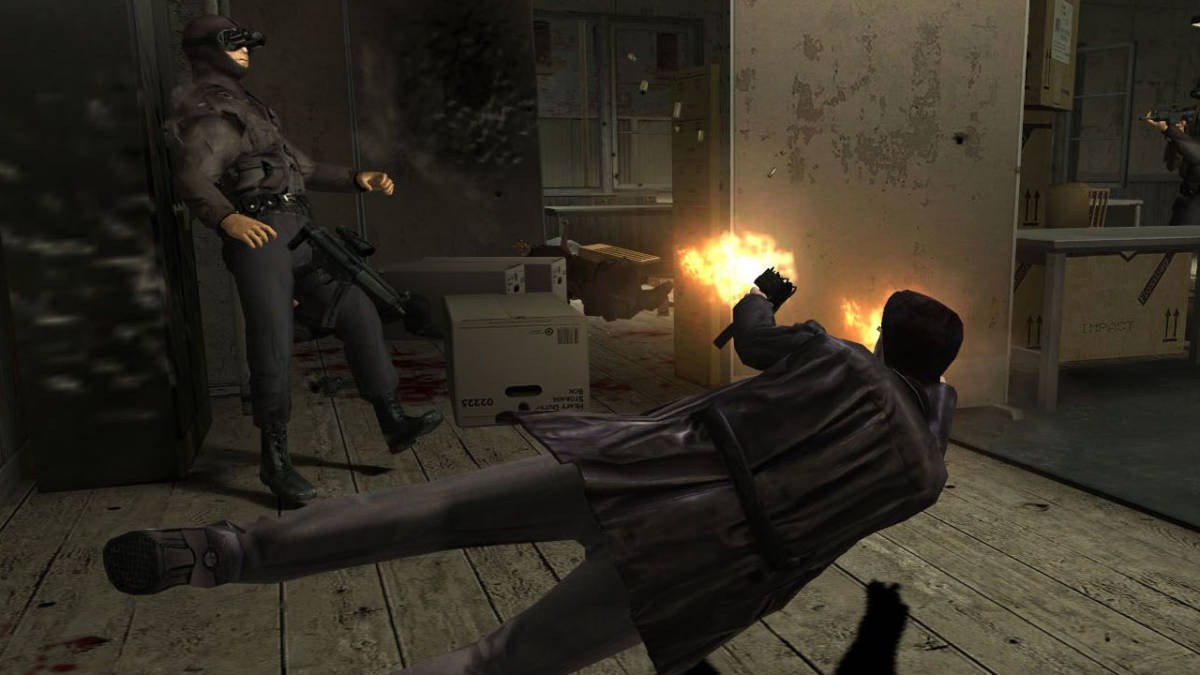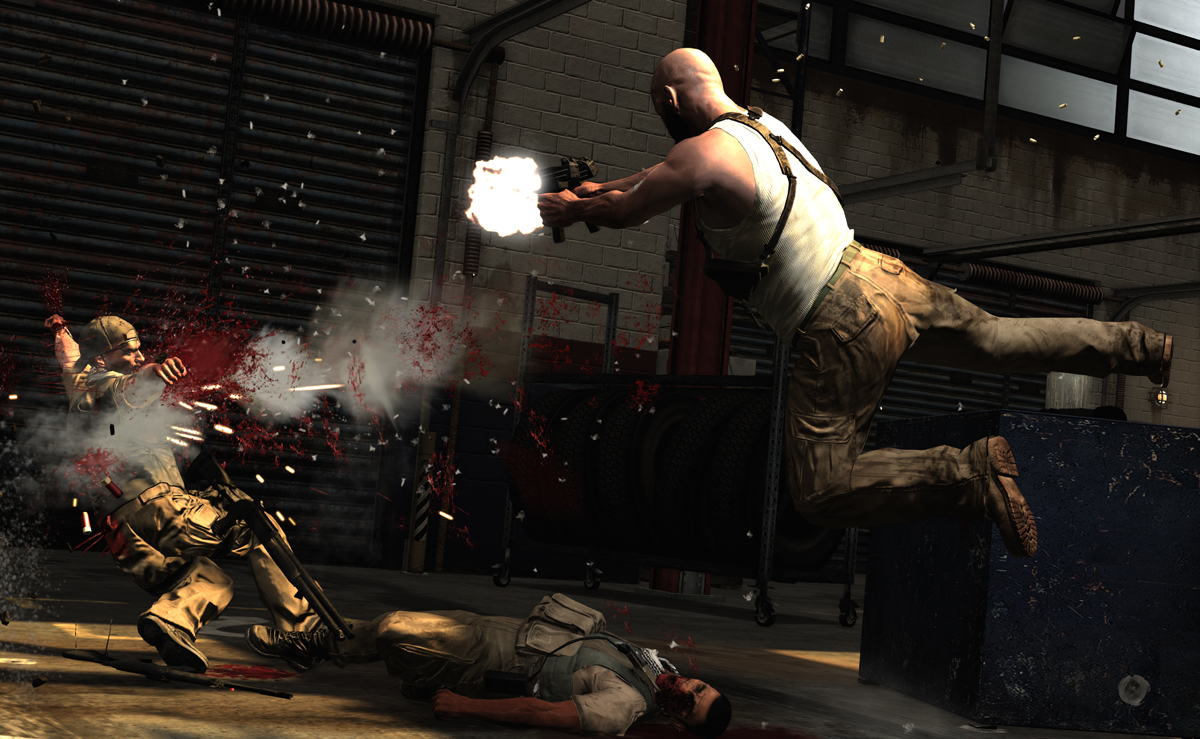When you hear someone mention film noir, several things come to mind. Corruption, violence, sketchy nightclubs serving powerful booze while the air is thick with the smell of cigarette smoke as rain comes down on a city as dark as its rotten soul. And in the middle of all of it, one man with nothing left to lose. And if you think of gaming when you hear of it, you inevitably think of Remedy’s 2001 third-person shooter, Max Payne.
Max Payne puts you in the role of the titular character, a hard-boiled New York detective that’s lost everything. The scene is immediately set with Max standing on the top of a skyscraper, snow whirling around him and law enforcement on the way as fast as possible. Max’s voice cuts through the cold with a chilling monologue about the final gunshot being an exclamation mark on his story. The scene shifts, going from in-engine cutscenes to narration over the panels of a graphic novel telling you how he lost his wife and newborn child when a drug-crazed maniac broke into his home. As his backstory is explained, Max’s adventure through a blizzard-sieged New York City begins.
Though Max Payne is a groundbreaking experience with its early examples of bullet time, years before F.E.A.R hit the stage, it has not aged perfectly. Running it on a modern OS requires you to use a few external fan-made patches to get the sound to run properly and the game to run at a wide-screen resolution. Once the bullets start flying, it all proves to be worth it as you delve into the game proper.

The game itself is a third person shooter, following Max as he wages a one man war against the mafia gunmen and scum inhabiting the city. It isn’t an easy fight, either – there are no magical health packs that immediately heal and restore Max to full strength or power shields that allow him to magically absorb 12 gauge shotgun rounds with his leather jacket. Instead Max uses bottles of painkillers found around the levels to deaden the pain of his wounds and restore his health, leaving healing supplies significantly limited. The lead flying through the air isn’t watered down, either; one good blast from a pump-action shotgun and Max’s adventure can come to a swift and painful end.
There is one ability that tilts the deck in Max’s favor, however: bullet time, a concept popularized by The Matrix. With the click of a button the action slows to a crawl, allowing the player to see bullets and projectiles coming towards Max and evade them, while also reacting to the numerous armed mafioso shooting at him. This gives the player the edge they need in gunfights where a second’s hesitation can spell death. Even with bullet time giving Max the edge in a gunfight, often the best strategy is to let the enemies come to you and deal with them as they appear.
Although there are several levels where the action gives you the feeling that you want to dive in and start fighting fast and furious, doing so is a quick way back to your last save. In fact, there are moments where the difficulty can border on cheap, with thugs that you didn’t notice through the grimy, dingy atmosphere getting the drop on you and taking you out before you have a chance to react. Combined with a lack of checkpoints, players will quickly learn to favor the quicksave key in order to keep from being sent back to the start of a level.

Added in are ‘nightmare’ sequences where Max finds himself running through a maze after being drugged up in some way. Often these become little more than mazes of blood trails where leaning on quicksaves becomes even more important, as there is some platforming involved and the jumping controls can be stiff and awkward.
The storyline written by Sam Lake (who also served as the model for Max in the first game), though clearly filled with the typical tropes and stereotypes tied to noir, is kept fresh with the graphic novel style cutscenes. In fact, the attention to detail in building a brutal, grim world is phenomenal – many times you will want to just stop and watch an episode of the numerous fictional TV shows playing that help make it feel real. From the cheesy-yet-surreal Address Unknown to the melodramatic Lords and Ladies and even Captain Baseball-Bat Boy cartoons, whenever you see a TV set playing it’s worth at least pausing the action to see what plays out. Radio and television broadcasts also help complete the picture of what’s going on outside of Max’s rampage through the city, making the snow-covered Big Apple come to life.
The story of the first game ended with Max finally getting his revenge before being taken away in the back of a police car. However, Max’s bloodstained story continued with Max Payne 2: The Fall of Max Payne in 2003. Two years have passed, and Max has been reinstated with the NYPD as a detective. His story begins with him investigating a warehouse where a group of thugs disguised as cleaners are in the middle of a hit and catch Max gets caught in the crossfire. During the ensuing shootout, Max stumbles across Mona Sax; a character that was presumed dead at the end of the first game. This, plus the return of several other ghosts of his past, propel Max once more into the rain-slicked streets of New York with nothing but his guns and a burning need for answers.
Max Payne 2 refined 1’s formula of using bullet time to get the drop on enemies, with adaptive difficulty taking some of the edge off. If the player dies too many times, the AI will be slowed and more painkillers will appear through the level to help make it through. The core bullet time mechanic was also tweaked; it begins with Max moving at the same slow motion as his enemies, but as he kills enemies he gets faster and faster. This proved to be a brilliant decision as combat became much more aggressive; no more sitting back and waiting for the enemies to trickle in, now the player is rewarded for pushing the bullet time button, rushing into a room, and blasting their way through the encounter.

The storyline this time is much more grounded as well with the primary narrative surrounding Mona Sax, her implication in a murder, and a budding romance with Max. Numerous characters make their return, and there is an underlying theme of tying off loose ends from the first game. Writer Sam Lake returned for the sequel, creating a plot that proves to be much more gripping and winding than the first game’s. The returning comic panel cutscenes help keep the player interested, wanting to delve further into the darkness as well, and their sparing use keeps the action going. This combines with some genuinely surreal levels including a horror funhouse based on the game’s fictional TV series Address Unknown and a level where you have to escort a mob higher-up through a turf war. The catch is he is wearing a Captain Baseball-Bat Boy costume with explosives planted in the head, so if he takes too many bullets the suit will explode.
Despite the improvements to gameplay, Max Payne 2 still has some difficult areas and the aforementioned escort level with Baseball-Bat Boy is a perfect example. There is still a need to have a hand near the quicksave key in order to prevent your progress from being lost, however encounters rarely feel as unfair as some of them did in the first game thanks to the improved bullet time.
At the end of Max Payne 2 his story was over; everything and everyone that had either crossed him or gotten close to him was dead, he had what answers he could get. This made the release of Max Payne 3, developed by Rockstar in 2012, all the more surprising – it had been nine years since Max’s last story, what else could there be?
Fans soon found out when they played what seemed to be a Max Payne game in name alone, swapping the gritty streets of New York with Brazil’s São Paulo and turning Max from a man with nothing to lose to a painkiller addicted alcoholic that was perpetually haunted by a past that he was trying to run away from. Now working as a private security contractor, Max finds himself once more in over his head while trying to protect a wealthy family.
The game is a clear product of its time with the combat built around an added cover system that takes away from the need for speed and using bullet time to kill your way through encounters. At least when you were able to play. Max Payne 3 had an aggravating love affair with small cutscenes that forced the player out of the action, making a large amount of the early areas of the game feel like little more than a glorified light gun game. Shoot bad guys, cutscene to next area, shoot more bad guys. This proved to be a massive source of frustration, keeping players from ever getting into the flow of the action until later in the game.

The storyline at least thankfully retains a level of intrigue that keeps players pushing on, however the change from traditional film noir and the lack of any returning characters besides Max did put a number of people off. Even so, it should be to Rockstar’s credit that they managed to write a decent story – the deaths of every main character except Max meant they had very little to work with. This doesn’t mean it was accepted by fans, and frankly it could easily have not been tied to Max Payne in any way.
There really isn’t much to be said about Max Payne 3: the initial levels feel exceptionally tedious with little more than single shootouts tied together with cutscenes while the later levels feel more like what a Max Payne game should have been the entire time, emphasizing speed and using bullet time to kill your way through armies of enemies. Rockstar attempted to use a good story to string it together, however it’s hard to remember much outside of what occasionally felt like plot twists for the sake of plot twists, and the loss of the graphic novel style drained any attempts to build the atmosphere of the original games.
Max Payne 3 was not a terrible game: generic, forgettable in many ways, but not terrible mechanically. All three of the games are worth playing, however if you were to only choose one, Max Payne 2: The Fall of Max Payne is widely considered the best of the series from a mechanical front.
With Remedy having moved on to other projects and Rockstar focusing on the open-world games, a fourth Max Payne game doesn’t seem to be coming anytime soon. It’s sad that a series ends on such a mediocre note, but perhaps it’s for the best that Max’s story remains finished on the closest thing to a happy ending that such a grim universe can offer. Max has found his peace, perhaps it’s time to let him enjoy it.
Check out this important article on the rise of gambling addictions in gaming, or if you’d rather read something a bit more uplifting, have a look at the few video game movie adaptations that aren’t bad.
Some of the coverage you find on Cultured Vultures contains affiliate links, which provide us with small commissions based on purchases made from visiting our site.

